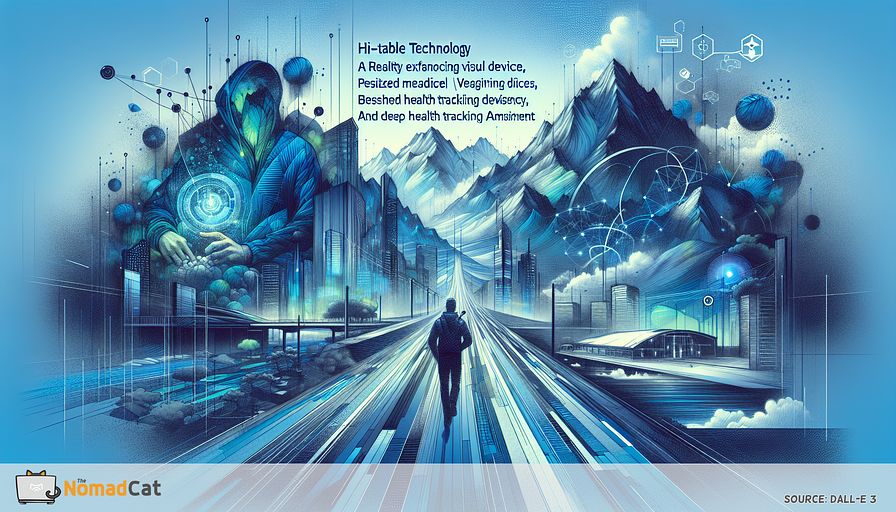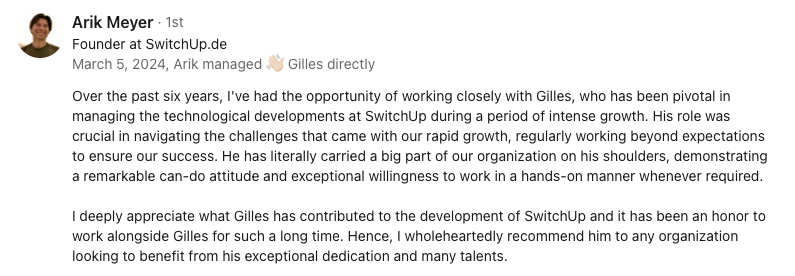Abstract:
As technology leaders seek to innovate and push the boundaries of what's possible, wearable technology stands out as a rapidly growing sector. This field has moved far beyond basic fitness trackers and smartwatches. Today, it encompasses smart clothing that can regulate temperature and track muscle activity, glasses augmented with reality to enhance perception and interaction with our environment, and health monitoring devices providing real-time data to medical professionals. These advancements offer a glimpse into a future where technology seamlessly integrates into our daily lives, improving health outcomes, enhancing personal productivity, and redefining entertainment. For technology directors and chief technology officers, understanding and leveraging the latest trends in wearable technology is crucial for staying ahead in an increasingly competitive landscape. This movement signifies a shift towards more personalized and preventative healthcare measures, improved efficiency in personal and professional tasks, and a deeper, more immersive interaction with the digital world.
Advancing Beyond Smartwatches: The Journey of Wearable Technology
Remember the early buzz around smartwatches and fitness trackers? I chuckled back then, thinking they were just glorified pedometers with geek appeal. Little did we know these devices were just the tip of the innovation iceberg. As I reflect on those initial gadgets, it's clear how far we've come from counting steps to saving lives.
Today, wearable technology isn't merely evolving; it's transforming vital industries and shaping the future. These devices are now pivotal in healthcare, offering real-time monitoring and predictive insights that can alert users and their healthcare providers to critical changes before they become emergencies. But that's just the start. In workplaces, they enhance productivity and safety, enabling workers and managers alike to monitor environments and personal health vitals effectively. And in our daily interactions, they’ve bridged the gap between the digital and physical realms more seamlessly than ever.
The trajectory of wearable tech is pointing toward even more sophisticated integrations. Smart clothing and augmented reality glasses are not just on the horizon; they are knocking on the door, ready to revolutionize how we interact with our surroundings even further. These advancements are setting the stage for an era where our clothes connect to the internet, and our eyewear delivers data as fast as we can blink – literally. It's an exhilarating time to lead and innovate in this space, embracing the challenges and opportunities these technologies bring.
As we delve deeper into the specifics of smart clothing and augmented reality in the coming sections, let's appreciate not just the technological strides we have made, but also the unexpected ways they empower us to lead healthier, more informed, and connected lives. The jump from those early fitness trackers to what lies ahead might just be the most exciting leap yet!
Deep Dive into Smart Clothing
The Fabric of the Future: Integrating Technology with Textiles
When I first encountered the concept of smart clothing, it seemed like a sci-fi fantasy. Yet, here we are, weaving technology into fabric to create garments that do more than just look good. Smart clothing is a fascinating development in wearable technology, intertwining advanced tech with everyday fabrics to create clothes that monitor health, regulate body temperature, and even track muscle activity.
This innovative merger uses sensors and conductive yarns almost imperceptibly incorporated into the garments. What makes these futuristic fabrics standout is their ability to gather a plethora of data about the wearer's physical state without impacting comfort or style. I've found myself marveling at the sleek design of these garments, which cleverly disguise their tech-enabled capabilities.
Turning Up the Heat: Body Temperature Regulation
One of the standout features of smart clothing is its ability to regulate the wearer's body temperature based on external conditions. Imagine a jacket that automatically warms you up on a frosty morning without fumbling around for a thermostat. These clothes use micro-sensors and climate control technology to adjust themselves to maintain a comfortable temperature. I once heard a colleague joke, "It's like having your mom tell you to wear a sweater, but it's your shirt doing the talking!"
Flexing Innovation: Muscle Activity Tracking
For fitness enthusiasts and athletes, smart clothing offers an incredible advantage by providing detailed insights into muscle activity. These garments use electromyography sensors to provide real-time data on muscle load, which can be crucial for optimizing workouts and preventing injuries. It's a game-changer for those of us who relish hitting a personal best without risking a pulled muscle.
Case in Point: Smart Clothing in Action
- Healthcare Integration: Smart clothing is not just for athletes. In healthcare, garments equipped with health-monitoring features can pre-emptively alert users and medical professionals about potential health issues. They give a whole new meaning to personalized and preventive healthcare. For instance, smart socks capable of detecting diabetic foot ulcers before they become visually apparent can significantly reduce complications in diabetic patients.
- Optimizing Physical Training: In sports, custom-fitted smart garments can help coaches tailor training regimes based on accurate data directly measured from an athlete's body. It's like having a high-tech personal assistant who's deeply attuned to your bodily needs.
In summary, smart clothing represents a profound shift towards more dynamic, preventive, and personalized healthcare. By marrying the elegance of design with cutting-edge technology, these garments not only assure style but also significantly enhance functionality. Every time I discuss or present these innovations at conferences or meetings, the room vibrates with excitement—or maybe it's just our smart wearables reacting to the enthusiasm in the air! Transitioning from traditional tech accessories to sophisticated, integrated wearable tech like smart clothing, we're not just witnessing a trend; we're stepping into the future of functionality and fashion. It gets me thinking; perhaps we're just a step away from our clothes doing the morning jogging for us!
Exploring Augmented Reality Glasses
The Fusion of Virtual and Real Worlds
Augmented reality (AR) glasses are not just another trendy gadget; they are powerful tools that enhance how we perceive and interact with our environments. Often, when I describe AR glasses, folks envision something out of a sci-fi movie, where digital information leaps into our real-world vista, and honestly, that's not too far from the truth. These devices overlay digital content onto the physical world in real time, creating a hybrid view that amplifies human experiences and interactions.
From navigating city streets overlaid with real-time traffic data to seeing a patient's medical history during a consultation, AR glasses enrich our interaction capabilities by blending digital elements seamlessly with real environments. The impact is profound, offering a hands-free, enhanced informational exchange that transforms ordinary tasks into extraordinary interactive experiences.
Leveraging AR in Various Sectors
- Education: In educational settings, AR glasses transport students beyond textbook illustrations. They animate complex scientific processes right before students' eyes—think seeing planetary orbits in physics or watching historical events unfold in a history class. This dynamic method of visual learning not only grabs their attention but also boosts comprehension and retention rates.
- Professional Training: AR glasses are transforming professional training, particularly in fields requiring high precision and safety. For instance, they enable new surgeons to perform virtual dissections or complex procedures under the guidance of overlayed step-by-step instructions, thereby reducing risks and improving outcomes.
- Entertainment: The entertainment industry has embraced AR to create immersive experiences that draw audiences into the heart of the action. Imagine, if you will, going to a concert where AR glasses overlay lyrics or streaming data about the band's history and song facts, or a sporting event where you can get instant stats and replays right in front of your eyes.
The examples are many, and they all highlight how AR glasses are pushing the boundaries between the digital and physical worlds to create novel, engaging experiences.
Real-World Applications Making a Difference
I recall a meeting where a prototype of the latest AR glasses was demonstrated. What seemed like magic at first was actually sophisticated technology at play. In fields like architecture and engineering, these glasses enable professionals to visualize and modify building models interactively within a real spatial context, leading to more accurate and immediate revisions and decisions.
In everyday life, navigation is another area where AR glasses truly shine. They can project directions, traffic updates, and even tourist information directly onto the user's field of view, making navigation intuitive and hands-free—no more staring down at a smartphone while trying to traverse busy streets.
Last but not least, the healthcare sector benefits significantly from AR glasses. Doctors can view vital diagnostics and imaging data while performing procedures, or overlay a patient’s medical data during examination, enhancing the accuracy and effectiveness of medical care. It's like having a superpower where vital information appears just when you need it, right in your line of vision.
As a leader in technology, witnessing and contributing to the evolution of AR glasses is thrilling. They are not merely products of imagination but are already changing how we interact with our world and each other. Every time I demo these glasses to someone unfamiliar, the usual reaction is a wide-eyed blend of surprise and delight. And honestly, who can blame them? We are literally seeing the future unfold right before our eyes. Through AR glasses, the fusion of digital convenience with real-world interaction isn't just a possibility—it's becoming a commonplace reality.
Implications for Technology Leaders
Staying Ahead: The Strategic Imperative
As technology leaders, the wave of advancements in smart clothing and augmented reality glasses isn't just a matter of fanciful thinking—it's a strategic priority. In this highly competitive market, ensuring our teams and companies remain at the forefront of innovation is not just advantageous; it's imperative. We find ourselves often mulling over not just how to embrace these technologies, but how to integrate them into our existing ecosystems in ways that are both innovative and practical.
Leading in tech often feels like being a perpetual student, required to stay abreast of the latest developments to pre-emptively tackle challenges even before they manifest. Adopting smart clothing and AR glasses into our strategy means thinking a step ahead to discern how these technologies might evolve and impact various sectors, pushing us to reconsider even the conventional boundaries of wearables.
Adopting and Adapting: The Role of Technology Leaders
- Healthcare Enhancement: With wearable tech like smart clothing enhancing patient monitoring and AR glasses providing real-time data overlays during surgeries, we are on the brink of a revolution in how medical care is delivered. For tech leaders, this implies not only adopting these innovations but also resolving the complex challenges of data security and privacy.
- Workplace Safety: Smart wearables offer unprecedented advantages in occupational safety, giving us real-time insights into worker health and environmental hazards. It's a potential game changer for industries from manufacturing to mining, where both risk mitigation and health monitoring can substantially reduce workplace accidents.
- Data Streamlining: As we move towards dense information networks, the ability of AR glasses to facilitate information flow in an intuitive and seamless manner opens new vistas in data management. For a CTO, it means devising strategies that integrate these data streams effectively without overwhelming the users.
These emerging tools are not just new gadgets; they are pivotal instruments in our leadership toolkit, empowering us to make better, faster, and more informed decisions.
Predicting the Trajectory of Wearable Technologies
What's next in the wearable technology frontier? If trends are any indication, the line between "tech" and "wearable" will continue blurring. Biosensors might become sophisticated enough to provide analytics akin to comprehensive medical exams daily. Perhaps a future cloth will actively change its fiber structure to enhance muscle performance or recovery based on our activities' real-time needs.
Every discussion, every prototype scrutinized in our labs potentially hints at these advancements. It feels somewhat like reading a thrilling novel where each chapter reveals new, unexpected plot twists.
A Reflection to Ponder
Amid adopting these advanced wearable technologies, one thought lingers: are we ready to manage the profound changes these innovations will bring? As we weave technology more intrinsically into the human experience, our responsibilities as leaders extend beyond mere implementation. We must consider the ethical, social, and practical implications—all while steering our ships through competitive storms.
So, fellow technology aficionados, as you reflect on integrating these exciting advancements into your strategies, ask yourself: How will you harness these technologies not just to enhance operational efficiencies but also to foster a more connected, informed, and safer world? Reflecting on this can ensure not just success in the marketplace but a legacy of innovation and responsibility.














